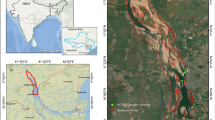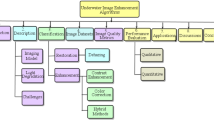Abstract
Images captured by UAVs above the sea surface often contain lots of highlight regions due to the specular reflection of solar radiation on the non-flat sea surface. The existence of a great deal of specular highlight components may cover the objects under the water which is negative to those applications based on the UAV remote sensing images. In this paper, we present a method to remove the specular reflection on the RGB images of ocean surface. The intensity of specular highlight components is much larger than that of diffuse components in the images, simply subtracting the highlight component form the original image will leave a lot of holes. So our method contains two main steps: highlight regions detection and restoration of those regions. We use the method based on the intensity ratio to extract the regions affected by the specular reflection. Then we use the local information around those highlight regions to restore the intensity of those pixels. The experimental results indicate that the proposed method can effectively remove the specular reflection and keep details of ocean surface images.






Similar content being viewed by others
References
Alsmirat MA, Jararweh Y, Obaidat I, Gupta BB (2017) Automated wireless video surveillance: an evaluation framework. J Real-Time Image Process 13(3):527–546. https://doi.org/10.1007/s11554-016-0631-x
Atawneh S, Almomani A, Al Bazar H, Sumari P, Gupta B (2017) Secure and imperceptible digital image steganographic algorithm based on diamond encoding in dwt domain. Multimed Tools Appl 76(18):18,451–18,472. https://doi.org/10.1007/s11042-016-3930-0
Bertalmio M, Sapiro G, Caselles V, Ballester C (2000) Image inpainting. In: Proceedings of the 27th annual conference on computer graphics and interactive techniques SIGGRAPH ’00. ACM Press/Addison-Wesley Publishing Co., New York, pp 417–424, https://doi.org/10.1145/344779.344972
Chan TF, Shen J (2001) Nontexture inpainting by curvature-driven diffusions. J Vis Commun Image Represent 12(4):436–449
Criminisi A, Pérez P, Toyama K (2004) Region filling and object removal by exemplar-based image inpainting. IEEE Trans Image Process 13(9):1200–1212
Doxani G, Papadopoulou M, Lafazani P, Tsakiri-Strati M, Mavridou E (2013) Sun glint correction of very high spatial resolution images. Thales, in Honor of Prof Emeritus Michael E Contadakis, pp 329–340
Drew MS, Joze HRV, Finlayson GD (2014) The zeta-image, illuminant estimation, and specularity manipulation. Comput Vis Image Underst 127:1–13
Efros AA, Leung TK (1999) Texture synthesis by non-parametric sampling. In: The Proceedings of the Seventh IEEE international conference on computer vision, 1999, vol 2. IEEE, pp 1033–1038
Goodfellow I, Pouget-Abadie J, Mirza M, Xu B, Warde-Farley D, Ozair S, Courville A, Bengio Y (2014) Generative adversarial nets. In: Advances in neural information processing systems, pp 2672–2680
Gupta BB, Agrawal DP, Yamaguchi S (2016) Handbook of research on modern cryptographic solutions for computer and cyber security
Hedley J, Harborne A, Mumby P (2005) Simple and robust removal of sun glint for mapping shallow-water benthos. Int J Remote Sens 26(10):2107–2112
Kay S, Hedley JD, Lavender S (2009) Sun glint correction of high and low spatial resolution images of aquatic scenes: a review of methods for visible and near-infrared wavelengths. Remote Sens 1(4):697–730
Kutser T, Vahtm (2009) A sun glint correction method for hyperspectral imagery containing areas with non-negligible water leaving nir signal. Remote Sens Environ 113 (10):2267–2274
Kutser T, Vahtmäe E, Paavel B, Kauer T (2013) Removing glint effects from field radiometry data measured in optically complex coastal and inland waters. Remote Sens Environ 133:85–89
Li J, Yu C, Gupta BB, Ren X (2017) Color image watermarking scheme based on quaternion hadamard transform and schur decomposition. Multimed Tools Appl https://doi.org/10.1007/s11042-017-4452-0
Martin J, Eugenio F, Marcello J, Medina A (2016) Automatic sun glint removal of multispectral high-resolution worldview-2 imagery for retrieving coastal shallow water parameters. Remote Sens 8(1):37
Nayar SK, Fang XS, Boult T (1993) Removal of specularities using color and polarization. In: 1993 IEEE Computer society conference on computer vision and pattern recognition, 1993. Proceedings CVPR’93. IEEE, pp 583–590
Overstreet BT, Legleiter CJ (2017) Removing sun glint from optical remote sensing images of shallow rivers. Earth Surf Process Landf 42(2):318–333
Pathak D, Krahenbuhl P, Donahue J, Darrell T, Efros AA (2016) Context encoders: feature learning by inpainting. In: Proceedings of the IEEE conference on computer vision and pattern recognition, pp 2536–2544
Radford A, Metz L, Chintala S (2015) Unsupervised representation learning with deep convolutional generative adversarial networks. arXiv:151106434
Richard MMOBB, Chang MYS (2001) Fast digital image inpainting. In: Appeared in the proceedings of the international conference on visualization, imaging and image processing (VIIP 2001). Marbella, pp 106–107
Shafer SA (1985) Using color to separate reflection components. Color Res Appl 10(4):210–218
Shen J, Chan TF (2002) Mathematical models for local nontexture inpaintings. SIAM J Appl Math 62(3):1019–1043
Shen HL, Zheng ZH (2013) Real-time highlight removal using intensity ratio. Appl Opti 52(19):4483–4493
Suo J, An D, Ji X, Wang H, Dai Q (2016) Fast and high quality highlight removal from a single image. IEEE Trans Image Process 25(11):5441–5454
Tan RT, Ikeuchi K (2005) Separating reflection components of textured surfaces using a single image. IEEE Trans Pattern Anal Mach Intell 27(2):178–193
Tan T, Nishino K, Ikeuchi K (2003) Illumination chromaticity estimation using inverse-intensity chromaticity space. In: 2003 IEEE Computer society conference on computer vision and pattern recognition, 2003. Proceedings, vol 1. IEEE, pp I–I
Telea A (2004) An image inpainting technique based on the fast marching method. J Graph Tools 9(1):23–34
Umeyama S, Godin G (2004) Separation of diffuse and specular components of surface reflection by use of polarization and statistical analysis of images. IEEE Trans Pattern Anal Mach Intell 26(5):639–647
Wang F, Ainouz S, Petitjean C, Bensrhair A (2016) Polarization-based specularity removal method with global energy minimization. In: 2016 IEEE International conference on image processing (ICIP). IEEE, pp 1983-1987
Wolff L B (1989) Using polarization to separate reflection components. In: IEEE Computer society conference on computer vision and pattern recognition, 1989. Proceedings CVPR’89. IEEE, pp 363–369
Xie J, Xu L, Chen E (2012) Image denoising and inpainting with deep neural networks. In: Advances in neural information processing systems, pp 341–349
Yang Q, Wang S, Ahuja N (2010) Real-time specular highlight removal using bilateral filtering. Comput Vis–ECCV 2010:87–100
Yang C, Lu X, Lin Z, Shechtman E, Wang O, Li H (2016) High-resolution image inpainting using multi-scale neural patch synthesis. arXiv:161109969
Yeh R, Chen C, Lim TY, Hasegawa-Johnson M, Do MN (2016) Semantic image inpainting with perceptual and contextual losses. arXiv:160707539
Yu C, Li J, Li X, Ren X, Gupta BB (2017) Four-image encryption scheme based on quaternion fresnel transform, chaos and computer generated hologram. Multimed Tools Appl https://doi.org/10.1007/s11042-017-4637-6
Acknowledgments
This work is supported by the National Natural Science Foundation of China(NSFC) Grants 61301241, 61602229, 41606198, 61501417 and 41706010, Natural Science Foundation of Shandong Provincial ZR2016FM13, ZR2016FB02, and Guangzhou Education Science ”Twelfth Five Year Plan” 2014 program grant 1201553242.
Author information
Authors and Affiliations
Corresponding author
Rights and permissions
About this article
Cite this article
Wang, S., Yu, C., Sun, Y. et al. Specular reflection removal of ocean surface remote sensing images from UAVs. Multimed Tools Appl 77, 11363–11379 (2018). https://doi.org/10.1007/s11042-017-5551-7
Received:
Revised:
Accepted:
Published:
Issue Date:
DOI: https://doi.org/10.1007/s11042-017-5551-7




